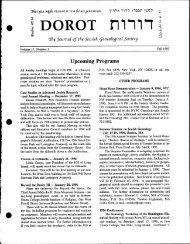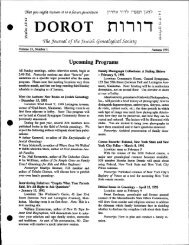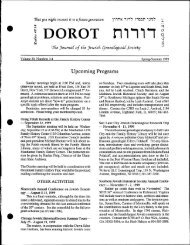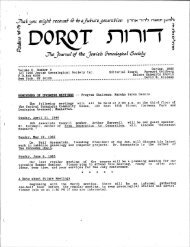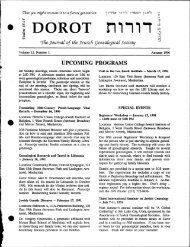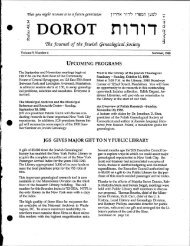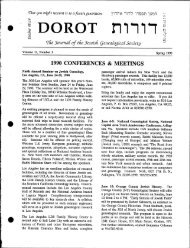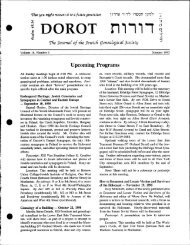24:3-4 Spring-Summer 2003 - Jewish Genealogical Society
24:3-4 Spring-Summer 2003 - Jewish Genealogical Society
24:3-4 Spring-Summer 2003 - Jewish Genealogical Society
Create successful ePaper yourself
Turn your PDF publications into a flip-book with our unique Google optimized e-Paper software.
Book Review<br />
by Randall C. Belinfante<br />
Sephardic Genealogy: Discovering Your Sephardic Ancestors<br />
and Their World by Jeffrey S. Malka. Bergenfield,<br />
NJ: Avotaynu, Inc., 2002.<br />
Jeffrey Malka has taken on a monumental task in his new<br />
work entitled Sephardic Genealogy and attempts to create<br />
a resource that will be of use to all genealogists. The result<br />
is a ground-breaking work which seeks to accomplish three<br />
objectives: it seeks to describe the history of the Sephardim<br />
from the time of the expulsion from Babylon down to<br />
present time; it attempts to explain the fundamentals for<br />
doing genealogical research, and it describes a number of<br />
the resources available for researchers investigating the<br />
various countries around the world possessing Sephardic<br />
descendants.<br />
From the first, the author is confronted with an extremely<br />
difficult issue: that of defining Sephardim. As Malka explains,<br />
there is a wide variety of definitions: from the strict<br />
view that Sephardic Jews derive purely from descendants<br />
of those Jews who were departed from Spain at the time of<br />
the expulsion in 1492 to the much more inclusive view that<br />
holds that the Sephardim include “…almost any Jew who<br />
is not Ashkenazic. 1 Malka concludes that the distinctions<br />
have become cemented based on the traditions observed:<br />
“Sephardim follow the Babylonian <strong>Jewish</strong> customs and<br />
Caro’s Shulchan Arukh, while Ashkenazim follow the Palestinian<br />
tradition” (p.7) and the interpretation of the<br />
Shulchan Arukh passed down to us through Moses Isserles.<br />
After sorting through this quagmire, Malka then proceeds<br />
to render a short history of the various groups of Sephardim,<br />
including the descendants of those expelled from Spain,<br />
those who lived under Islamic rule in North Africa and the<br />
East, and those who were descendants of the famous<br />
Geonim of Babylonia. He adds to this sections dealing with<br />
the Sephardic languages and with Sephardic names. In the<br />
former section he describes the various languages used by<br />
the Sephardim and the manner in which they have evolved<br />
over time, while in the latter he describes how Sephardic<br />
names have changed and evolved over time, with special<br />
conventions used in certain areas. All of these elements are<br />
extremely useful for the novice genealogist who is trying<br />
to get some grasp of the Sephardim and their multi-faceted<br />
culture.<br />
Yet, Malka is not satisfied with this introduction, but he<br />
expresses an interest in offering assistance to the beginner<br />
by describing a series of genealogy basics. Here he explains<br />
what to do to get started, how to organize and document<br />
one’s records, how to utilize calendars and date conversions,<br />
some of the important periodicals useful to the<br />
genealogist, and some tips about employing computers<br />
and the Internet. He also provides a brief review of some<br />
of the genealogy software that is available, and describes<br />
some of the unique resources available for doing<br />
Sephardic genealogy.<br />
In the third section of the book, Malka proceeds to elaborate<br />
on the various resources that are available for research<br />
in Sephardic genealogy. He wends his way through each<br />
of the countries of the Sephardic world (from Iran to the<br />
Caribbean), giving a brief history of each region (as far as<br />
the information is relevant to the genealogist), and then<br />
describing some of the resources available for doing family<br />
history research in each country. Those available differed<br />
significantly from place to place. In some countries<br />
one finds archives, vital records, and cemetery records,<br />
while in such other regions as the Balkans, information is<br />
much more meager. For each place Malka makes suggestions<br />
for further reading, and he even suggests research<br />
strategies in a few instances for dealing with regions that<br />
have a complex organization to their records. One of<br />
Malka’s areas of real expertise is Turkey and the Ottoman<br />
Empire, and for this reason, he offers a number of additional<br />
tools to assist the researcher. He offers an introduction<br />
to Turkish as well as insights into the Turkish calendar.<br />
This is in addition to discussions of Turkish civil, cemetery,<br />
and genealogical records. Malka thus attempts to offer<br />
some guidance to researchers by probing all regions of<br />
the Sephardi world.<br />
Even with all this information, Malka is not satisfied, and<br />
so he supplements his extensive resources with a discussion<br />
of the Internet. A general description of the topic is<br />
offered earlier in the book, but in this section Malka proceeds<br />
to examine and evaluate the Internet resources available<br />
in individual countries of the Sephardic world. Looking<br />
first at such elements as the Crypto-Jews and Sephardic<br />
family pages, Malka tries to include in his survey as many<br />
websites about as many topics as he can muster. Unfortunately,<br />
on this point, Malka’s work falls victim to the rapid<br />
advances and changes of Internet technology. Indeed, new<br />
websites are popping up every day, and those that exist are<br />
prone to change. Although Malka has made a valiant effort,<br />
it is apparent that the World Wide Web has seen some<br />
changes in the short time since his book’s release.<br />
Yet, there is still more to Malka’s work, in the form of a<br />
series of highly informative appendixes. This information<br />
includes a diverse group of topics, ranging from “Etymology<br />
of selected Sephardic names” and the “Arabic Alphabet”<br />
to “Inquisition Tribunals in Spain” and a list of<br />
(continued on page 6)<br />
Dorot • <strong>Spring</strong>-<strong>Summer</strong> <strong>2003</strong> -7-





